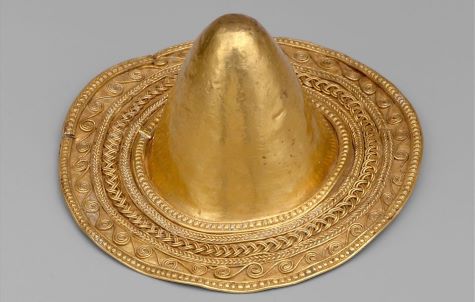Nadene Goldfoot
Moses had the ark created and used gold several ways to cover it inside and out. Where did he get the gold when he was the responsible man moving 600,000 people from Egypt to Canaan, which could be done today in 9 hours and 25 minutes on route 90 by car from Cairo to Jerusalem. Then, by walking that many people on a different route, it took 40 years. A troy ounce of gold today would cost us $1,851.05.
We remember that Jacob, grandson of Abraham, took his family of 70 which included an extended family, to Egypt at a time of extreme famine, which should have been walking or riding donkeys or camels along the same route 400 years earlier than Moses's Exodus. He settled in Goshen in Eastern Egypt, and his family multiplied, and their increased population scared the pharaoh, thinking they would take over Egypt or at the least, assist their enemies. So The Egyptians solved that predicted problem by taking them as slaves. Jacob, however, had died before that had happened at age 147 and was buried in the Cave of Machpelah in Hebron along with Sarah, Abraham and Isaac, his father. Time was counted as 400 years in Egypt from the time of entrance to the time of the Exodus.
The Exodus with Moses happened in about 1225-1215 BCE during the reign of Pharaoh Memeptah or even earlier in 1445 BCE.
Exodus Expedition About to Leave for Canaan
The Israelites acted on Moses' word and asked the Egyptians
for silver and gold jewelry and for clothing. And the Lord gave
the people such favor in the Egyptians' sight that they gave
them what they requested. In this way they plundered the
Egyptians (Exodus 12:35–36).
"The children of Israel carried out the word of Moses. They requested from the Egyptians silver vessels, gold vessels, and garments. HaShem (G-d) gave the people favor in the eyes of the Egyptians and they granted their request----so they emptied Egypt." Example: Finger Ring depicting King Akhenaten and Queen Nefertiti as Shu and Tefnut (1353-1336 BCE). This ring was found at Amarna. The hieroglyphs may be read as an ideogram. The two seated figures are probably Akhenaten (left) and Nefertiti (right) as the deities Shu (air as indicated by the feather he holds) and Tefnut (moisture). They were father and mother of the earth and sky. / Photo courtesy MMA, Public Domain
 They felt they deserved some compensation after being slaves for some 400 years.
They felt they deserved some compensation after being slaves for some 400 years. This event was remembered forever by being in the
Torah as a written law. (See below).
"But when you send him away from you free, you
shall not send him away empty-handed. Adorn him
generously from your flocks, from your threshing
floor, and from your wine cellar....."
(Deuteronomy15:13–14, )
And the Egyptians; where did they get all their gold in the first place?
Ancient Egyptian gold statue of the protecting goddess, Serket at the Tutankhamun exhibition. / Photo by mountainpix, depositphotos, Creative CommonsEgypt is/was a land rich in gold, and ancient miners employing traditional methods were thorough in their exploitation of economically feasible sources. In addition to the resources of the Eastern Desert, Egypt had access to the riches of Nubia, which is reflected in its ancient name, nbw (the Egyptian word for gold). The hieroglyph for gold—a broad collar—appears with the beginning of writing in Dynasty 1, but the earliest surviving gold artifacts date to the preliterate days of the fourth millennium B.C.; these are mostly beads and other modest items used for personal adornment. Gold jewelry intended for daily life or use in temple or funerary ritual continued to be produced throughout Egypt’s long history.
Pendant in the Shape of an Uraeus (2030-1650 BCE). The uraeus was a royal symbol of protection, as the representation of a rearing cobra could magically spit fire at the enemies of Egypt from its perch on the king’s forehead. / Photo courtesy MMA, Public Domain
Resource:
Tanakh, Stone Edition, Artscroll..
The New Standard Jewish Encyclopedia
https://andrehenry.medium.com/exodus-pt-13-leaving-the-ghetto-with-gold-8366203495aa#:~:text=The%20Israelites%20acted%20on%20Moses,12%3A35%E2%80%9336).
https://brewminate.com/nebu-gold-in-ancient-egypt/








No comments:
Post a Comment